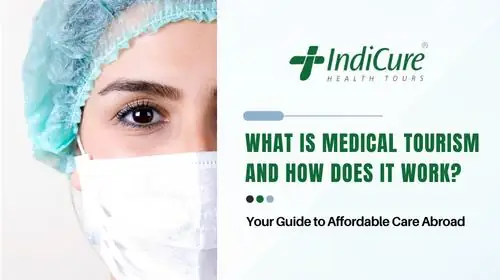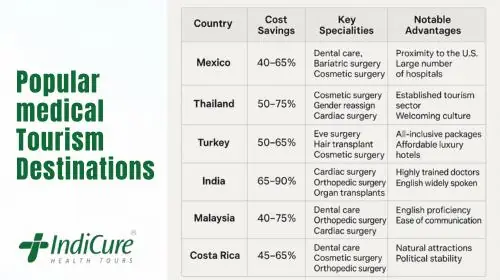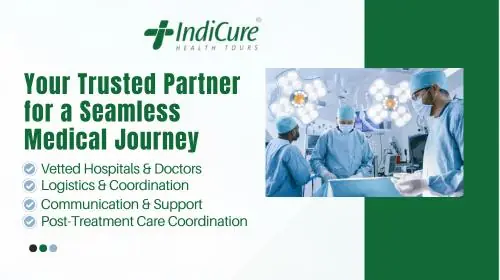What is Medical Tourism and How Does It Work? Your Guide to Affordable Care Abroad

Introduction: The High Cost of Health: A Western Dilemma
Imagine facing a critical surgery or a much-needed medical procedure, only to be confronted with staggering costs that are simply out of reach. For millions in Western countries, especially those who are uninsured or underinsured, this is a harsh reality. In the United States, medical debt is a major issue, with people owing at least $220 billion. Approximately 14 million U.S. adults have medical debt exceeding $1,000, and 3 million individuals owe more than $10,000. This financial pressure makes affording healthcare a challenge for nearly half of all U.S. adults.
Even in countries with universal healthcare, such as Canada and the UK, patients often face very long wait times for elective surgeries. For example, patients needing orthopedic surgery or neurosurgery may wait 57.5 weeks and 46.2 weeks, respectively. These issues of high costs and long waits create a significant dilemma for people needing medical care.
This is where the concept of medical tourism emerges as a powerful and increasingly viable solution, offering a path to quality, affordable care that might otherwise be inaccessible. This article will explain what is medical tourism and how does it work.
What is Medical Tourism and How Does It Work?
At its core, Medical tourism is simply the practice of traveling to another country specifically for medical care. While many people do so to find less expensive procedures, others travel for treatments that are not available in their home country or to see healthcare professionals who share their cultural background or language. The process usually starts when a person identifies a medical need that can't be met affordably or quickly at home. They then research international healthcare options, often with help from specialized companies or medical concierge services that can help find suitable clinics and professionals abroad. Once the patient makes a decision, they travel to the destination, undergo treatment, and return home, ideally with a plan for post-operative care.
While cost savings are a primary motivator for many, especially uninsured Westerners, the decision to pursue medical tourism is often multi-faceted. Access to specialized or innovative procedures not approved or available domestically, or the ability to bypass long waiting lists, adds significant value beyond just price. So, what is medical tourism and how does it work for patients with a wider range of needs? It's about gaining control over one's health journey and finding solutions that address everything from financial concerns to timely access to advanced care.
Why Medical Tourism? Bridging the Gap for the Uninsured
For individuals in Western countries struggling with high healthcare costs and limited access, medical tourism offers a compelling alternative. One of the most significant benefits is the potential for substantial cost savings. For example, costs for procedures can be 50-60% lower in Thailand, 40-60% lower in Mexico, and up to 80% lower in India compared to U.S. prices. These savings are substantial enough to make life-changing procedures financially feasible for those who couldn't otherwise afford them.
Beyond the financial aspect, medical tourism provides timely access to care, directly addressing the long wait times common in many Western healthcare systems. Being able to schedule a procedure in a matter of weeks instead of waiting months or years gives patients crucial control over their health timeline. For someone living with chronic pain, timely care is just as important as cost savings. The question of what is medical tourism and how does it work becomes a matter of comprehensive value, not just a cheap option. Additionally, medical tourism offers access to specialized or unavailable treatments. Patients may seek care abroad for procedures that are not approved or are legally or ethically prohibited in their home country, such as specific cosmetic surgeries, advanced dental procedures, or IVF, or certain oncology treatments.
Top Destinations for Medical Tourism: Quality Care, Global Savings
The medical tourism landscape is global, with several countries offering a mix of affordability, quality, and specialized care. Patients often choose destinations based on cost-effectiveness, high standards of care, convenience, opportunities for post-treatment recovery, and the chance to experience a new culture.
- Thailand: A pioneer in medical tourism, Thailand is known for world-class cosmetic surgery, cardiology, orthopedics, and dentistry. Patients can save 50-60% compared to U.S. costs, and the country offers English-speaking staff and luxurious hospital facilities.
- Mexico: With its proximity to North America, Mexico is a convenient and affordable option, especially for dental care, bariatric surgery, and orthopedic procedures. Patients can save 40-60% compared to the U.S.
- India: As a global leader, India excels in complex surgeries and specialized treatments like oncology and cardiac procedures. Patients can save up to 80% compared to Western nations and benefit from highly skilled surgeons and JCI-accredited hospitals.
- Malaysia: A rising star in medical tourism, Malaysia is known for its excellent healthcare system and advanced technology, with specialties in oncology, cardiology, and fertility treatments. With English-speaking professionals, patients can save 60-80% compared to the U.S.

Your Journey to Healing: The Medical Tourism Process Explained
Traveling for medical treatment might seem overwhelming, but the medical tourism process can be broken down into three clear phases: pre-travel, during treatment, and post-treatment.
-
Phase 1: Pre-Travel Preparations
This phase is all about preparation of the medical tour, including talking to your local doctor, researching international facilities, and gathering and translating all medical records. You also need to manage logistics like getting a written breakdown of costs, securing travel documents, and setting up an emergency contact plan. A medical tourism facilitator can be invaluable here.
-
Phase 2: During Treatment
Upon arrival, the focus shifts to the procedure and immediate recovery. A quality medical tourism experience often includes airport pickup and escort services to the hospital or hotel. Clear communication with the medical team is essential during this time.
-
Phase 3: Post-Treatment & Follow-up Care
Before leaving the hospital, you should get a detailed discharge plan and a copy of your medical records to share with your doctor back home. It is crucial to follow all post-surgery guidelines, especially regarding air travel.
Navigating the Path: Understanding and Mitigating Medical Tourism Risks
While medical tourism has many benefits, it's important to be aware of the potential risks. Addressing these challenges proactively is the key.
- Quality and Safety: Healthcare standards can vary, leading to risks of substandard care. To mitigate this, choose hospitals with international accreditations like Joint Commission International (JCI), which follow strict global standards.
- Continuity of Care: A major challenge is ensuring proper follow-up care at home. The solution is to work with both your local and international doctors to create a detailed follow-up plan before you travel.
- Travel Risks: Traveling after surgery increases the risk of blood clots, such as deep vein thrombosis (DVT). You should strictly follow post-operative flight restrictions, for example, avoiding flying for at least -a week after a majorsurgery.
- Communication and Culture: Language barriers and cultural differences can cause misunderstandings. Choosing facilities with multilingual support or using a medical tourism facilitator who provides translation services can help.
These risks highlight that medical tourism is a serious decision. A proactive approach, including comprehensive planning and working with a trusted facilitator, is essential for a safe and successful outcome. So, when considering what is medical tourism and how does it work for you, be sure to plan carefully.
IndiCure Health Tours: Your Trusted Partner for a Seamless Medical Journey
Navigating the complexities and potential risks of international medical care can be daunting. This is where a dedicated medical tourism facilitator becomes an indispensable partner. They handle everything from identifying the right surgeon to coordinating travel logistics. IndiCure Health Tours provides comprehensive support, ensuring a streamlined and safer medical journey.
- Vetted Hospitals & Doctors: IndiCure connects you with a network of JCI-accredited hospitals and thoroughly vetted doctors, ensuring care meets global safety and quality standards.
- Logistics & Coordination: IndiCure handles all travel logistics, including hotels and airport transfers, and coordinates medical appointments and surgery schedules for a seamless journey.
- Communication & Support: The company helps overcome language barriers by providing translation services, a 24/7 emergency contact, and daily check-ins during recovery.
- Post-Treatment Care Coordination: IndiCure ensures continuity of care by facilitating medical records, arranging follow-up calls, and assisting with post-operative care.

IndiCure acts as a crucial "risk buffer" and "empowerment enabler" for patients, transforming a potentially daunting high-risk endeavor into a manageable and safe option. This comprehensive support is at the core of understanding what is medical tourism and how does it work with a professional partner.
Frequently Asked Questions (FAQs)
Here are some common questions about medical tourism:
-
What procedures are most commonly sought by medical tourists?
The most frequently pursued procedures include cosmetic surgery, dental care, oncology, fertility treatments, and organ transplantation.
-
Will my domestic insurance cover medical tourism?
Generally, the costs are out-of-pocket, and you should always check your specific insurance plan.
-
How do I ensure the quality of care abroad?
Look for hospitals accredited by recognized bodies like Joint Commission International (JCI).
-
What about follow-up care when I return home?
Plan for a comprehensive follow-up with both your domestic and international doctors before you travel.
-
What are the risks of traveling after surgery?
Traveling post-surgery increases the risk of blood clots. It is generally recommended not to fly for at least 7-10 days after a surgical procedure.
-
Can I travel with my prescription medications?
Yes, but you must check with the foreign embassy of your destination country to confirm that your medications are allowed.
Conclusion: Empowering Your Health Journey
For many people in Western countries, high costs and long waits make medical care inaccessible. Medical tourism offers a powerful solution, providing a way to get affordable, timely, and specialized care. The success of medical travel depends on careful planning and choosing the right medical tourism partner. Contacting a dedicated medical tourism facilitator like IndiCure Health Tours simplifies the entire process by vetting hospitals, managing logistics, providing translation services, and coordinating post-treatment care. With a focus on transparency, patient safety and delight, they help you navigate the complexities of international healthcare with confidence, providing a clear answer to what is medical tourism and how does it work for you.